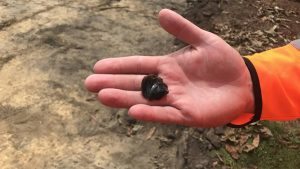Remains of an Maori village have been uncovered by roadworks at a roundabout in Papamoa, Tauranga, New Zealand.

Archaeologists identified more than 300 archaeological features at the site, including large post holes, hangi pits (pit ovens), a cache of hangi stones and kumara pits. Initial assessment of the finds allows to date the site to between 1600-1800 AD, but carbon dating shell and charcoal samples would help determine when it was occupied. Most of the post holes were structurally aligned and could be the floors of whare – a Maori hut. Four adjacent whare were excavated. Further post holes at the southern end of the site formed a large structure. Numerous crop storage pits were located, most likely for kumara, although several smaller bin pits may have stored other items.

Researchers state that pieces of obsidian were unearthed as well including complete flakes and angular fragments. They all appeared to have been sourced from Tuhua (Mayor Island). This find suggests tool manufacturing was taking place at the site. The obsidian may also have been used for cutting and scraping implements for food processing or working with plant and fibre material. Tuhua obsidian was widely used and is found across New Zealand. The discovery-site is located in the middle of a culturally significant area in the Papamoa Hills, and it was likely that the Maori constantly moved between the hills and the coastal dune plains.
(after New Zealand Herold)